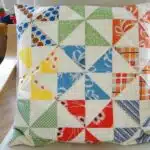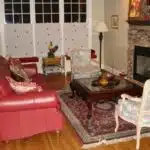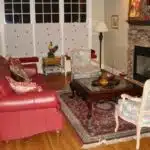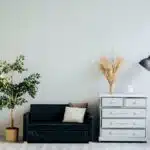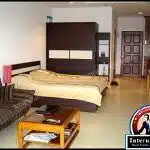As a home decorating expert, I have noticed that many homeowners shy away from incorporating darker colors into their home decor. However, dark colors can add depth, drama, and sophistication to any space. With the right balance and combination of colors, textures, and lighting, you can create a cozy and welcoming atmosphere in your home using dark hues.
In this article, we will explore how to decorate your home with dark colors. We will discuss the benefits of using darker shades in your decor, how to choose the right color palette for your space, and practical tips for incorporating dark colors into different areas of your home. Whether you’re looking to create a moody ambiance or add some contrast to an otherwise neutral room, our guide will help you achieve a stylish and inviting look that reflects your personal taste and style.
The Benefits Of Decorating With Dark Colors
Decorating your home with dark colors may seem intimidating, but there are numerous benefits to this style choice. One of the main advantages is that darker shades can make a space feel more cozy and intimate. This is because they absorb light rather than reflecting it, creating a warm and inviting atmosphere that encourages relaxation and comfort.
Contrary to popular misconceptions, using dark colors doesn’t necessarily make a room feel small or cramped. In fact, when used correctly, darker shades can actually make a space appear larger than it is. This is because they create depth and dimension in a room, adding visual interest and drawing the eye around the space.
Another benefit of incorporating dark colors into your home decor is that they lend an air of sophistication and elegance to any room. Whether you opt for rich jewel tones or dramatic black and white contrasts, darker hues exude a sense of luxury that can elevate even the simplest of spaces.
As you consider incorporating dark colors into your home decor, it’s important to keep in mind some guidelines for choosing the right color palette for your space. By selecting complementary shades and avoiding overwhelming saturation, you can create a stylish and balanced look that will enhance the beauty of your home.
Choosing The Right Color Palette For Your Space
Neutrals are a great starting point when choosing a color palette for a space, providing a backdrop for accent colors to stand out and create a stylish and inviting atmosphere. Warm tones, such as reds, oranges and yellows, can be used to create a cozy and comfortable atmosphere while cool tones, such as blues, greens and purples, can be used to create a more relaxed and calming atmosphere. Contrast is also an important factor to consider in creating a pleasing space, with the use of light and dark colors to create balance. Finally, the use of color psychology, texture, pattern, furniture, lighting, finishes and accessories should all be taken into consideration when creating a desirable space.
Neutrals
When it comes to choosing the right color palette for your home, one of the biggest decisions you’ll make is between neutrals and bold colors. While bold colors can add excitement and drama to a space, neutrals are a timeless choice that can create a sense of calm and balance. But don’t mistake neutral for boring – when used correctly, neutrals can be just as impactful as bolder hues.
One way to use neutrals in your home décor is to opt for matching tones throughout the space. This creates a cohesive look that feels polished and put-together. However, if you’re feeling more daring, consider using contrasting shades of neutral tones instead. For example, pairing warm beige walls with cool gray furniture can create a dynamic yet understated look.
Another benefit of using neutral colors in your home is their versatility when it comes to decorating styles. Whether your style is traditional or modern, neutrals can be incorporated seamlessly into any design aesthetic. And if you ever feel like switching things up down the line, neutral walls and furniture provide a blank canvas for experimenting with new accent colors or patterns.
In conclusion, whether you choose to go bold or stick with neutrals, it’s important to consider how each color will contribute to the overall mood and vibe of your home. Neutrals offer a classic choice that provides flexibility in terms of decorating styles and allows for endless possibilities when it comes to accessorizing. By considering options such as matching or contrasting tones within this palette, you can create a space that feels truly personalized while maintaining an air of sophistication and elegance.
Accent Colors
When it comes to choosing the right color palette for your home, there are many factors to consider. One important element is the use of accent colors. Accent colors are a great way to add interest and personality to a space. They can be used to create a focal point or draw attention to specific areas of a room. Using contrasting accent colors can be particularly effective in creating visual interest and depth.
When choosing accent colors, it’s important to consider the overall mood and vibe of your space. If you’re going for a calm and serene atmosphere, you may want to opt for soft blues or greens as accents. On the other hand, if you want to create a more energetic and vibrant space, using bold reds or oranges can be an excellent choice.
Finally, don’t be afraid to get creative with your accent colors! You can incorporate them in unexpected ways, such as through artwork, throw pillows, or even painted furniture pieces. The key is to experiment until you find the perfect balance that reflects your personal style while also complementing the other elements in your space. With some careful consideration and thoughtful planning, using accent colors can take your home décor from ordinary to extraordinary!
Understanding The Psychology Of Color
When it comes to decorating your home with dark colors, it is important to understand the psychology of color. Dark colors such as black, navy blue, and deep shades of purple can create a sense of drama and elegance in a space. However, it is important to consider cultural influences and color symbolism when incorporating these hues into your home decor.
For example, in Western cultures, black is often associated with mourning and sadness. In contrast, in some Eastern cultures, black is seen as a symbol of power and sophistication. Similarly, purple has different meanings across cultures; in Western cultures, it is often associated with royalty and luxury, while in some Asian cultures it represents wealth and prosperity.
When incorporating dark colors into your home decor, it is important to consider the mood you want to create in the space. Dark hues can evoke feelings of intimacy and coziness but can also make a room feel smaller or more confined. To balance out the richness of dark colors, consider adding lighter accents such as white or metallics. Additionally, pairing dark walls with natural elements such as wood or plants can add warmth and texture to a space.
Transition: Now that we’ve discussed the importance of understanding color symbolism and cultural influences when decorating with dark colors let’s explore how to create a mood with these rich hues.
Creating A Mood With Dark Hues
Dark colors can evoke a sense of sophistication, elegance, and drama in any room. However, it is important to use them carefully to avoid making the space feel too gloomy or claustrophobic. One way to achieve this is by creating contrast with lighter elements such as white walls, light-colored furniture, or metallic accents. This will help balance the darkness and create a dynamic visual interest.
Another technique for using dark colors effectively is to pair them with light accents. For example, if you have a navy blue accent wall in your living room, consider adding some cream-colored throw pillows or a beige rug to soften the look. Alternatively, you can use dark colors sparingly in minimalist design schemes where less is more. A black lampshade or charcoal gray curtains can add depth without overwhelming the space.
Incorporating dark colors into your home decor can be intimidating but is ultimately rewarding when done right. Creating contrast and balancing dark hues with light accents are essential techniques that will help you achieve an elegant and sophisticated look without feeling oppressive. In the next section, we will explore how to mix and match different shades of dark colors to create a cohesive color palette that suits your style and personality.
Mixing And Matching Different Shades Of Dark Colors
When using dark colors in home decor, it’s important to mix and match different shades to create a cohesive look. One way to do this is by mixing patterns. Incorporating different patterns, such as stripes and polka dots, can add interest and depth to a room. When doing so, it’s essential to choose patterns that complement each other rather than clash.
Another way to mix and match different shades of dark colors is by creating contrast. For example, pairing a deep navy blue with a lighter shade of gray can create an eye-catching contrast that adds visual interest to the space. Additionally, using accents such as metallic finishes or bright pops of color can help break up the darkness and add some dimension.
Overall, mixing and matching different shades of dark colors is all about finding balance. By incorporating various patterns and contrasting elements, you can create a harmonious look that feels both cozy and stylish. In the next section, we’ll explore how layering textures can add even more depth to your decor scheme.
Layering Textures For Added Depth
An essential aspect of decorating with dark colors is creating textural contrasts to add depth and interest to the space. Layering fabrics is one way to achieve this effect. Start by selecting a variety of textiles with different textures, such as velvet, linen, leather, or wool. Combine these materials in decorative pillows, throws, and curtains to create layers of softness and visual appeal.
To avoid overwhelming the space with too many patterns or textures, consider balancing out the dark colors with lighter shades or neutral tones. For instance, if you have a dark blue sofa, pair it with light-colored cushions and a cream rug to create a harmonious balance. You can also incorporate metallic accents like brass lamps or silver candlesticks for a touch of shine and glamour.
When layering textures, it’s important to pay attention to the tactile experience as well. Soft textiles like plush rugs or silky curtains can add an element of comfort and coziness that contrasts well with the boldness of dark paint or wallpaper. Experiment with different combinations until you find the right mix that suits your style and personality.
Moving on from textural contrasts and layered fabrics, using accent colors is another effective way to add interest to your home decor scheme. By introducing pops of color through decorative objects like artwork, vases, or cushions, you can create focal points that draw the eye around the room. In the next section, we will explore some easy ways to incorporate accent colors into your design plan without overwhelming the space.
Using Accent Colors To Add Interest
- Contrasting colors are an effective way to add interest to a space when decorating with dark colors.
- Incorporating texture can add dimension and depth, breaking up the monotony of a dark color palette.
- Accent pieces can be used to introduce brighter colors and patterns, creating visual interest.
- Contrasting colors can be used to create a bold and dynamic look, drawing attention to certain features of the room.
- Texture can also be used to create subtle contrast, helping to break up the darkness of the color palette.
- Accent pieces can also be used to introduce texture, adding a tactile element to the space that can enhance the overall design.
Contrasting Colors
Color combinations are essential to achieving a harmonious and visually appealing home. When it comes to decorating with dark colors, contrasting hues can be a great way to add interest and depth to a space. Bold patterns in contrasting colors can create an eye-catching focal point that draws the attention of visitors.
One way to add contrast is by incorporating pops of bright or light-colored accents throughout the room. For instance, pairing deep navy walls with crisp white trim or accessorizing with gold accents against black walls creates an elegant and sophisticated look. Additionally, mixing textures and materials such as velvet, leather, and wood can help bring out the varying tones in your chosen color palette.
When experimenting with contrasting colors in your decor, it is important to strike a balance between boldness and cohesiveness. One effective technique is using a monochromatic scheme as the base for your design while adding small doses of complementary hues for added interest. This approach allows you to incorporate accent colors without overwhelming the overall aesthetic of your space.
By carefully selecting contrasting color combinations and incorporating bold patterns into your decor, you can create a dynamic and inviting ambiance in your home. Remember that decorating should reflect your personal style while also being functional for daily use. Don’t be afraid to experiment until you find the perfect balance of color and texture that suits you best!
Texture
Now that we have discussed the importance of contrasting colors in adding interest to home decor, let’s move on to another essential element: texture. Texture is often overlooked but plays a crucial role in creating a cozy and inviting atmosphere. Using patterns can add texture and depth to a space, whether it be through bold geometric prints or subtle floral designs. Mixing different textures such as soft fabrics like velvet or furry throws with hard materials like wood or metal can create a dynamic visual experience.
Another way to incorporate texture is through lighting. Different lighting fixtures can create various shadows and highlight different surfaces, emphasizing the texture of each material. For example, using dimmer lights in an area with exposed brick walls will bring out the roughness and character of the bricks.
When choosing textures for your decor, it’s important to consider balance and cohesion just as you would with contrasting colors. The key is not to overdo it; too many textures can result in a chaotic and overwhelming space. Start by selecting one or two focal pieces with unique textures, then build around them with complementary materials.
Incorporating texture into your home decor adds depth and warmth to any room. By using patterns, mixing materials, incorporating lighting, and finding the right balance, you can create an inviting ambiance that reflects your personal style while also being functional for daily use.
Accent Pieces
When it comes to adding interest and personality to your home decor, accent colors are a powerful tool. By strategically incorporating pops of color throughout a space, you can create a cohesive and dynamic look that reflects your personal style. However, it’s essential to use accent colors in moderation and balance them with complementary hues. Too much color can lead to visual clutter and overwhelm the senses.
Another way to add interest to your decor is through accent pieces. These are items that draw the eye and serve as focal points in a room. Using patterns on accent pieces such as throw pillows or curtains can add texture and depth, while incorporating metallics like brass or copper can bring shine and sophistication to a space. The key is to choose accent pieces that complement the overall aesthetic of the room without overpowering it.
When selecting accent pieces, it’s important to consider scale and proportion. A large statement piece like an oversized wall art or a bold rug can anchor a room and set the tone for the rest of the decor. On the other hand, smaller accents like decorative vases or candles can be used to add subtle pops of color throughout a space. By carefully curating your accent pieces, you can elevate your home decor from ordinary to extraordinary.
Incorporating Dark Colors In Small Spaces
When it comes to incorporating dark colors in small spaces, maximizing contrast is key. This means pairing dark walls with light furniture and accessories, or vice versa. For example, a deep navy blue accent wall can make a small room feel cozy and intimate, but pairing it with white or light-colored furniture can help prevent the space from feeling too closed-in.
Another way to incorporate dark colors in small spaces is by creating illusions that make the room appear larger than it actually is. One such illusion is using mirrors strategically throughout the space to reflect light and create depth. Additionally, opting for furniture with clean lines and minimal ornamentation can help prevent the space from feeling cluttered or cramped.
When done right, incorporating dark colors in small spaces can add drama and sophistication to your home decor. By maximizing contrast and creating illusions, you can transform even the tiniest of rooms into a cozy retreat that feels both stylish and inviting. In the next section, we’ll explore how to add drama to your living room using dark colors and bold accents.
Adding Drama To Your Living Room
To add drama to your living room, consider incorporating a contrast of dark and light colors. This can be achieved by using a dark-colored sofa or accent wall while pairing it with light-colored curtains, rugs, and pillows. The contrast in colors will create depth and dimension in the room, making it look more inviting and comfortable.
Lighting is also crucial in creating a dramatic ambiance in your living room. A combination of ambient lighting and task lighting can help set the mood for different occasions. For example, during movie nights, dim the lights and turn on the table lamps or floor lamps to create a cozy atmosphere. On the other hand, brighten up the room during game nights by turning on all available lighting fixtures.
Incorporating decorative elements such as artwork, sculptures, plants, or books can also contribute to adding drama to your living room. These items can be used to create visual interest and draw attention to specific areas of the room. Consider placing them strategically around the space so that they complement the overall design scheme while adding a personal touch.
Transition: Now that you’ve added drama to your living room with dark colors, let’s move on to creating a cozy bedroom with similar hues.
Creating A Cozy Bedroom With Dark Colors
- When selecting dark colors for a bedroom, consider the room’s natural light sources as well as the overall style of the space.
- To create a cozy atmosphere, layer different textures in the room, such as velvet, linen, and faux fur.
- To break up the darkness of the room, accessorize with colorful accent pieces and artwork.
- Accent furniture can provide pops of color to a room with dark colors.
- Dark colors can also provide a calming atmosphere with the use of soft, muted hues.
- To create a warm, inviting atmosphere, mix and match various textures and colors for a cozy and inviting bedroom.
Choosing Dark Colors
Are you looking to create a cozy bedroom with dark colors? Choosing the right shades of dark colors can make your room feel comfortable and inviting. When selecting colors, consider using a mix of patterns to add depth and texture to your space. By combining different patterns such as stripes, florals, or geometric shapes, you can create a cohesive look that will give your bedroom a unique and personalized touch.
In addition to mixing patterns, adding bold accessories can also enhance the overall appearance of your bedroom. Consider using decorative pillows or throws in contrasting colors to draw attention to specific areas of your space. You might also want to incorporate statement pieces such as an accent chair or an eye-catching lamp to create a focal point in the room. By carefully selecting these accessories, you can elevate the look of your bedroom without overwhelming it.
Ultimately, creating a cozy bedroom with dark colors requires careful consideration and planning. While it may seem like a daunting task at first, by following these tips on choosing the right shades of color and incorporating bold accessories, you can transform your space into a warm and inviting sanctuary that you’ll love spending time in. So why not get started today and begin enjoying all the benefits that come with having a stylish and relaxing bedroom?
Layering Textures
When it comes to creating a cozy bedroom with dark colors, layering textures is an essential step. By incorporating different textures into your space, you can add depth and dimension to your room, making it feel more inviting and comfortable. Consider using a mix of materials such as velvet, linen, or wool to create a tactile experience that will make your bedroom feel like a warm and welcoming sanctuary.
Combining patterns is another way to add interest and texture to your space. By mixing different patterns such as stripes, florals, or geometric shapes, you can create a cohesive look that will give your bedroom a unique and personalized touch. When choosing patterns, aim for a balance between bold and subtle prints to avoid overwhelming the space.
Choosing the right lighting is also crucial in creating a cozy bedroom with dark colors. Soft lighting can create a warm ambiance that will make your space feel more relaxing and inviting. Consider using table lamps or floor lamps with dimmer switches to control the brightness of the room. You might also want to incorporate string lights or candles for an added touch of warmth and coziness. By layering textures, combining patterns, and choosing the right lighting, you can transform your dark-colored bedroom into a comfortable retreat that you’ll love spending time in.
Accessorizing With Color
In addition to layering textures, combining patterns, and choosing the right lighting, accessorizing with color is also an important aspect of creating a cozy bedroom with dark colors. Adding pops of color can brighten up the space and create a visually stimulating environment. However, it’s important to use color strategically and in moderation to avoid overwhelming the room.
One way to accessorize with color is by incorporating bold patterns into your decor. Mixing different patterns such as stripes, polka dots, or chevron can add interest and dimension to your space. When doing so, it’s important to choose patterns that complement each other rather than clash. Consider using complementary colors or sticking to a specific color scheme for a cohesive look.
Another way to accessorize with color is by adding accent pieces such as throw pillows, rugs, or curtains in contrasting hues. For example, if you have a deep navy blue wall, consider adding pops of gold or rust-colored accessories for an added touch of warmth and dimension. Remember that less is often more when it comes to using color in home decor. By incorporating small accent pieces strategically throughout the room, you can create a cozy and inviting atmosphere without overwhelming the space.
Enhancing Your Dining Room With Dark Hues
After creating a cozy bedroom with dark colors, it’s time to move on to the dining room. Dark hues can make for an elegant and formal space, perfect for hosting dinner parties and special occasions. However, it’s important to strike a balance between sophistication and comfort to ensure your guests feel at ease.
One way to achieve this balance is by using patterns in your dining room decor. Incorporating patterned curtains or wallpaper can add visual interest and break up the monotony of solid colored walls and furniture. Choose patterns that complement your color scheme and style of your home. For instance, if your home has a rustic aesthetic, consider using plaid or paisley prints.
When it comes to lighting options for a dark colored dining room, you want to create a warm and inviting atmosphere without sacrificing functionality. Pendant lights are an excellent choice as they provide ambient lighting while also adding visual appeal. Alternatively, wall sconces can illuminate artwork or other decorative elements on the walls. Don’t forget about dimmer switches – they allow for versatility in lighting depending on the occasion.
- Creating contrast with metallic accents such as brass or gold.
- Incorporating natural elements such as wood or plants for texture.
- Adding a statement piece of furniture like a unique chandelier or bold rug.
As a home decorating expert, my ultimate goal is to create spaces that serve both form and function while reflecting the homeowner’s personality and preferences. With these tips in mind, you can transform your dining room into an inviting space that balances elegance with comfort.
To continue enhancing your home with dark colors, let’s now move on to stylish bathrooms with dark hues.
Stylish Bathrooms With Dark Colors
When adding stylish lighting to a bathroom with dark colors, look for fixtures that will match the color scheme. Consider bold accents such as a dark colored wall mirror or a sink in a deep hue to create a dramatic effect. Adding natural elements like wood flooring or furniture can bring warmth to the room. For a modern look, be sure to include chrome fixtures to complete the design.
Stylish Lighting
Stylish lighting is essential when decorating your bathroom with dark colors. Dark color contrast can create a cozy and dramatic ambiance, but it can also make the room feel smaller and gloomy without proper lighting. Therefore, choosing the right light fixtures is crucial to enhance the beauty of your bathroom.
To start, consider installing a statement chandelier or pendant light in the center of your bathroom. This will provide an elegant focal point that complements the dark walls perfectly. You can also add wall sconces on each side of your vanity mirror to provide task lighting for applying makeup or shaving. The key is to balance function and style by using different types of lighting sources strategically.
Another stylish lighting option is under-cabinet lights. These lights can be installed underneath your vanity cabinets or floating shelves to illuminate the countertop area. Not only do they create an ambient glow that highlights the dark color contrast, but they also add a touch of sophistication to your bathroom design. Plus, they are energy-efficient and easy to install.
In conclusion, stylish lighting plays a vital role in decorating bathrooms with dark colors. By choosing statement light fixtures and incorporating different types of lighting sources, you can create an inviting atmosphere that enhances the beauty of your space. Don’t be afraid to experiment with different styles and designs until you find the perfect match for your personality and taste!
Bold Accents
Creating contrast is an essential element when decorating your bathroom with dark colors. It can make the space feel more dynamic and visually appealing. One way to achieve this is by incorporating bold accents into your design. Bold accents can add a pop of color or texture that contrasts with the dark walls, making them stand out and creating an eye-catching effect.
When it comes to using bold accents in your bathroom, metallics are a great option. Metallic finishes such as gold, silver, or copper can add a touch of glamour and sophistication to your design. You can incorporate metallics through fixtures such as faucets, towel bars, or light fixtures. Alternatively, you can use metallic accessories like vases, trays, or soap dispensers to create a cohesive look.
The key to using bold accents successfully is to keep it simple and not overdo it. Choose one or two accent pieces that complement the dark color scheme and stick with them. This will create a cohesive look that doesn’t feel overwhelming or cluttered. With the right balance of bold accents and dark colors, your bathroom will be transformed into a stylish and inviting space that you’ll love spending time in!
Decorating Your Kitchen With Dark Accents
When it comes to decorating your kitchen, incorporating dark accents can create a bold and sophisticated look. One way to achieve this is by choosing dark kitchen backsplashes. These can range from sleek black tiles to textured natural stone in shades of gray or brown. Dark backsplashes can add depth and contrast to a kitchen with lighter countertops or cabinets.
Another option for adding dark accents to your kitchen is through bold kitchen cabinets. Dark-toned cabinets in shades like navy blue, forest green, or deep burgundy can make a statement while still being functional. Pairing these cabinets with light countertops and backsplashes can create an eye-catching contrast that draws the eye towards the center of the room.
When designing a kitchen with dark accents, it’s important to balance out the overall look with plenty of natural light and lighter-colored surfaces. This will prevent the space from feeling too heavy or enclosed. Additionally, incorporating metallic elements like stainless steel appliances or copper fixtures can add shine and reflection that help brighten up the room.
Transition: While incorporating dark accents into your kitchen design can be visually stunning, it also requires special attention when it comes to maintenance and upkeep. Here are some practical tips for maintaining dark-colored surfaces in your home.
Practical Tips For Maintaining Dark-Colored Surfaces
As we’ve explored in the previous section, incorporating dark accents into your kitchen can add a touch of sophistication and elegance. But as with any home decorating trend, it’s important to know how to maintain these dark surfaces to keep them looking their best.
Cleaning Tips:
- Use a microfiber cloth to dust dark furniture regularly.
- Avoid using harsh chemicals on dark surfaces as they can cause discoloration or damage.
- For tough stains, use a gentle soap and warm water solution and quickly dry the area afterwards.
Furniture Protection:
- Invest in high-quality furniture protectors such as slipcovers or coasters.
- Place felt pads under heavy items such as lamps or vases to prevent scratches.
- Avoid placing dark furniture in direct sunlight as it can fade over time.
When it comes to decorating with dark colors, there are plenty of seasonal trends and budget-friendly options available. In the fall and winter months, deep shades of burgundy and navy can create a cozy atmosphere. In the spring and summer, lighter shades of gray or blue can help create a calming space.
Budget-friendly options for incorporating dark colors into your home include painting an accent wall or adding throw pillows in rich hues. Another option is to shop secondhand stores for unique pieces that can be easily painted or refurbished.
Now that we’ve covered some practical tips for maintaining dark-colored surfaces and discussed popular seasonal trends and budget-friendly options for decorating with dark colors, let’s move on to frequently asked questions about this trend.
Frequently Asked Questions About Decorating With Dark Colors
When it comes to decorating with dark colors, there are often many questions that arise. Here are some frequently asked questions and answers to help guide you in your design choices.
Lighting considerations play a crucial role when using dark colors in your home decor. Dark colors tend to absorb light, which can make a room appear smaller and less inviting. To combat this, it is essential to incorporate multiple sources of lighting into the space, such as floor lamps, table lamps, and overhead lighting fixtures. Additionally, using light-colored lampshades or bulbs can reflect more light and brighten the room.
Choosing the right furniture is also key when decorating with dark colors. Opt for pieces that are light or neutral in color to balance out the darker tones in the room. This will prevent the space from feeling too heavy or overwhelming. Additionally, incorporating texture through fabrics like velvet or linen can add dimension to the space without adding more color. Overall, choosing furniture that complements rather than competes with the dark color scheme will create a cohesive and inviting atmosphere in your home.
Conclusion
Decorating your home with dark colors can bring a sense of sophistication and elegance to any space. By carefully selecting the right palette, understanding color psychology, and creating a mood with dark hues, you can transform your living space into a stylish sanctuary. Mixing and matching different shades of dark colors can also add depth and dimension to your decor.
When it comes to incorporating darker colors into your home, bathrooms and kitchens are great places to start. Dark accents in these spaces can create a bold statement while maintaining practicality. However, it’s important to keep in mind that maintaining dark-colored surfaces requires extra care and attention.
In the words of legendary designer Dorothy Draper, “The best rooms have something to say about the people who live in them.” So why not let your decor speak volumes about your personal style? With these tips and tricks, you can confidently decorate your home with dark colors that reflect your unique taste and personality. Just remember to choose wisely, considering both the aesthetic appeal and practicality of each choice. Whether it’s bold blacks or deep blues, there’s no doubt that decorating with dark colors can create a stunningly dramatic effect in any room.
Image Credits
- “File:Kit socks color 3 stripes dark blue.png” by Crelache (featured)












